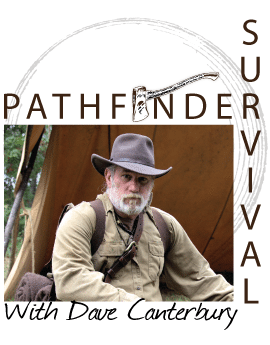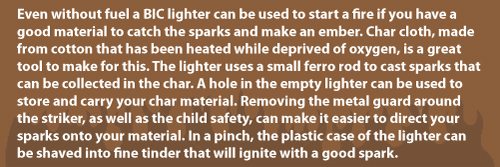 As the 2nd C in our 10 Cs of survival, combustion is one of the most crucial elements to short term survival. Your ability to quickly make a sustainable fire in any weather condition can, in an emergency, be the difference between life and death. To this end, we should always keep multiple ways to start a fire layered within our kit as well as on our person. I personally recommend three combustion devices to all my students and there is nothing wrong with multiples in different areas of the kit.
As the 2nd C in our 10 Cs of survival, combustion is one of the most crucial elements to short term survival. Your ability to quickly make a sustainable fire in any weather condition can, in an emergency, be the difference between life and death. To this end, we should always keep multiple ways to start a fire layered within our kit as well as on our person. I personally recommend three combustion devices to all my students and there is nothing wrong with multiples in different areas of the kit. Carrying a fire kit should become second nature. Fire is a lifesaver and provides warmth, light, the ability to purify water, and protection from predators. Carry the right tools and learn how to make fire.
Carrying a fire kit should become second nature. Fire is a lifesaver and provides warmth, light, the ability to purify water, and protection from predators. Carry the right tools and learn how to make fire.The most logical choice obviously is something that will create open flame in most cases and that would be a lighter. Now just any lighter is really not good enough, as just like all these items, it must be the most robust and easy to use of its type. For me the BIC brand lighter is the top dog in this category. Why, you ask? Well first they are simple to use as well as inexpensive - you could have five of them for less than 10 dollars. They are very reliable and will work in most conditions easily.
There are a few things to think about with a simple BIC. First, remember that the fuel supply is limited and while it may light many cigarettes, holding the button down several minutes at a time to ignite stubborn tinder sources is a different story and will use fuel quickly. My general rule is 5-seconds on the button. If the tinder will not ignite in 5-seconds you have another issue to fix and are wasting a resource. The next thing to remember is that BIC’s are not a fan of cold weather. When temps dip to freezing, they sometimes don’t light. So, keep them in a pocket near your body heat so that they will work easier in cold weather.
 A few items carried with you at all times can ensure you have the ability to start a fire in most conditions. A fire kit consisting of a BIC lighter, a Ferro Rod, and a magnifying lens will provide the tools to create a fire.
A few items carried with you at all times can ensure you have the ability to start a fire in most conditions. A fire kit consisting of a BIC lighter, a Ferro Rod, and a magnifying lens will provide the tools to create a fire.First thing I do when I buy a new BIC is remove the child safety, this just gets in the way of operation especially with cold hands or with gloves. Removing this will make the lighter easier to dry out for lighting after it has been soaked as well. So, you got your lighter wet? Step 1: shake it vigorously to remove excess water and then blow into it from the top forcefully to remove the rest. Next use the tail of a shirt or a dry rag to dry the friction wheel as you slowly rotate it. The lighter should work now easy enough, but it takes practice. If all else fails after these steps, run the lighter up your pant leg a few times to create heat. By spinning the friction wheel, this should dry it out pretty quickly.



The second form of combustion I recommend is a
 Ferrocerium Rod. This is a rod made from multiple pyrophoric metals, that when material is quickly removed from the rod with an object that is harder than the material the rod is made from will combust and become molten metal and sparks that are approximately 5,000 degrees F. Here is the thing that makes a Ferro Rod a good choice. It will work on any good combustible tinder source and lasts much longer than the lighter's fluid - it will also work even if it is wet. So, while the tinder must be a bit better without open flame, the longevity and waterproof factors make it a great emergency resource.
Ferrocerium Rod. This is a rod made from multiple pyrophoric metals, that when material is quickly removed from the rod with an object that is harder than the material the rod is made from will combust and become molten metal and sparks that are approximately 5,000 degrees F. Here is the thing that makes a Ferro Rod a good choice. It will work on any good combustible tinder source and lasts much longer than the lighter's fluid - it will also work even if it is wet. So, while the tinder must be a bit better without open flame, the longevity and waterproof factors make it a great emergency resource.My recommendation is buy the largest rod you can find because the smaller ones can be hard to hold onto in colder weather and most of the handles will come off eventually, unless they are pinned in place. The other reason you want a larger rod is that the more time you have contact with the surface area to remove material and the larger that surface area is, the more sparks the rod will throw and in an emergency, this is important.
 A good lens can be improvised from an old pair of binoculars, a magnifying glass, a bottle, a pair of eye glasses, a plastic baggie filled with water or urine, or even from a broken flashlight or car headlight. Anything that will focus the rays of the sun into a point will work. Use it with something like punk wood processed into dust to get your ember.
A good lens can be improvised from an old pair of binoculars, a magnifying glass, a bottle, a pair of eye glasses, a plastic baggie filled with water or urine, or even from a broken flashlight or car headlight. Anything that will focus the rays of the sun into a point will work. Use it with something like punk wood processed into dust to get your ember.The 3rd item to always have on hand is a good magnification lens of at least 5-power. With a mag lens, again size does matter more than power. Collecting the sun to a focal point works much more effectively with a bit larger lens. I recommend one about 2-4” in diameter (Hint: the bottom lens from a cheap pair of yard sale binoculars works great). Now there are advantages and disadvantages here. The advantage is that the sun is a renewable resource and you will never run out of it unless it’s a cloudy day. The disadvantage is that the tinder source for this method must be very combustible, things like charred materials and punky woods, as well as many tree funguses work best.
Now this brings us to our final point and that is NEXT FIRE mentality. The first fire you start is often the easiest fore and the next one may be the hardest due to use of resources to get the initial emergency fore going. So, we must always take advantage of the first fire to make the second one easier. To this end, we should always make char of some sort with the initial fore to save for the next fire as all of these methods from a spent lighter to a mag lens will easily ignite char to make blowing tinder materials to flame much easier.
Making char is not difficult; we need a chamber of sorts that we can place into the fire that will let gas escape, but not allow oxygen in. For this, we generally use the 3rd item in the Cs, our Container. We need to use some type of natural material in the chamber like a piece of cotton t-shirt and place it in the fire. A 4” square generally takes about 10 minutes to be done and when the container cools, you will have char. There are many other materials you can also use for this, but that is a longer conversation than we have room for here. The bottom line is, Fire is Life. It disinfects and warms water, cook’s food, signals for rescue, fire hardens tools, sterilizes needles and blades and provides us with resources like char, coal, and ash. I hope this helps to shed a little more “light” on an important part of your outdoor adventures.
About the Author - Dave has been published in Self Reliance Illustrated, New Pioneer, American Frontiersman, and Trapper's World, and has appeared on the cover of Backwoodsman Magazine. Dave’s book BushCraft 101 is a two-time NY Times Best Seller. In addition to writing about survival, Dave is the Co-Owner and Supervising Instructor of The Pathfinder School in SE Ohio, the United States' premier school for self reliance. The Pathfinder School is listed as one of the top 12 Survival Schools in the U.S. by USA TODAY. Dave holds a bachelor’s degree in Wilderness Ministry from Frontier Christian University is certified in Advanced Search and Rescue,Wilderness First Aid/CPR, as an Expert Trapper by the Fur Takers of America, and holds basic and intermediate certificates from the International School of Herbal Arts and Sciences.

